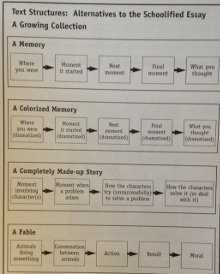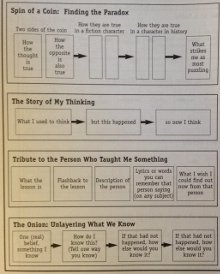Essays and Text Structures with Elementary Students
What's an essay?
Can we really nail down a definition and explain it in a way that eight-year-olds not only understand it, but also generate on a test? Timed, Typed, Assessed, my data is YOURS (sung to the tune of the Stevie Wonder super wedding song, Signed, Sealed, Delivered).
Tom Newkirk discusses how we kind, sorta’ messed up the idea of the essay with the creation of textbooks in his short, but necessary read, The School Essay Manifesto. Newkirk criticizes the thesis controlled, five paragraph, easily graded, textbook writing and says, “We got it wrong.” Real essayists like E.B. White and de Montaigne wanted the essay to be more of an exploration of thought. Not just proving a thesis.
In Tom Romano’s book, Writing with Passion, the five-paragraph essay is referred to as five-paragraph-you-know-what. He couldn’t even bring himself to write the word essay after the chains of a number is uttered before it. But it’s not only the number that’s a bit unnerving; it’s the required number of sentences for each paragraph, the thesis, the required number of details, etc...
Like de Montaigne, I want to see into the mind of my students when they write an essay. I want thoughts. I want questions. I want opinions. I want stories. I want voice. I want to see and hear a human being in that writing, darn it! It’s an essay. Everything and anything is possible. These are eight-year-olds, dude. They’re kids. It should come out in their writing.
If we teach (and if eight-year-olds can learn) the typical passionless structure of the textbook essay, kids will snag in the thorns of the terminology (thesis, details, paragraphs, etc...) inevitably losing their thoughts on the subject. Instead of getting down to it and answering the question, which they are totally capable of, kids are left wondering, “What’s a thesis again?”

You can find the example text structures at http://gaetanpappalardo.com/post/100020293080/alternative-text-structures-copyright-discover

C- See
3- 3
P- Parts/Paragraphs
O- Organized
Link to C3-PO Graphic: http://www.onkidwriting.com/image/100014397760
You know, it’s not going to help everyone. But at least when that tricky essay word shows up, your students can think about a shiny, gold droid, that will help organize their thoughts, write some paragraphs, and maybe even score some points for the good guys.
How do you help kids structure their writing without losing authenticity?
Note: images used courtesy of Discover Writing Press.